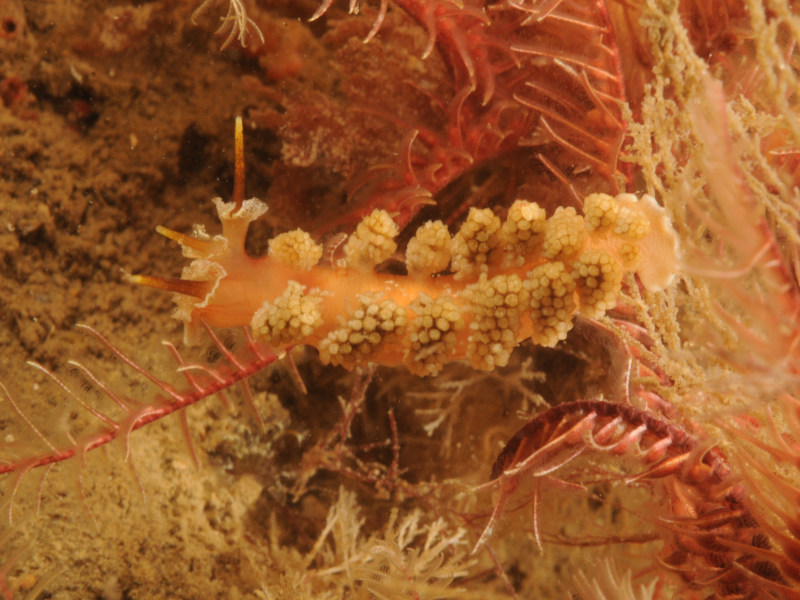A sea slug (Doto fragilis)
Distribution data supplied by the Ocean Biodiversity Information System (OBIS). To interrogate UK data visit the NBN Atlas.Map Help
| Researched by | Natalie Sweet | Refereed by | Admin |
| Authority | (Forbes, 1838) | ||
| Other common names | - | Synonyms | - |
Summary
Description
The body of Doto fragilis varies from light to dark brown with larger specimens tending to be darker. White patches or spots occur along the the sides of the body, particularly on the dorsum and on the margins of the oral veil, which is expanded into lobes. The rhinophores are long, slender and smooth, with trumpet shaped sheaths which flare at the outer rim. Up to 10 pairs of large tuberculate cerata are present in two rows along the sides of the body, each with up to 13 concentric circles of pale tubercles. Maximum recorded size is 34 mm.
Recorded distribution in Britain and Ireland
Found all around the British Isles.Global distribution
-Habitat
Doto fragilis occurs up to 200 m depth. This species is known to feed on the hydroids Nemertesia antennina, Nemertesia ramosa, Halecium halecium and Halecium muricatum.Depth range
-Identifying features
- Brown hue in skin but no dark surface pigment spots
- White glands along flanks of body
- Up to 10 pairs of cerata, each with up to 13 concentric circles of pale tubercles
Additional information
No text entered
Listed by
- none -
Bibliography
Howson, C.M. & Picton, B.E., 1997. The species directory of the marine fauna and flora of the British Isles and surrounding seas. Belfast: Ulster Museum. [Ulster Museum publication, no. 276.]
Hunnam, P. & Brown, G., 1975. Sublittoral nudibranch mollusca (sea slugs) in Pembrokeshire waters. Field Studies, 4, 131-159.
Picton, B. E. & Morrow, C.C., 1994. A Field Guide to the Nudibranchs of the British Isles. London: Immel Publishing Ltd.
Thompson, T. E. & Brown, G. H., 1976. British Opisthobranch Molluscs. London: Academic Press. [Synopses of the British Fauna, no. 8.]
Thompson, T.E. & Brown, G.H., 1984. Biology of Opisthobranch Molluscs, vol. II. London: Ray Society.
Thompson, T.E., 1972. Eastern Australian Dendronotoidea (Gastropoda: Opisthobranchia). Zoological Journal of the Linnean Society, 51(1), 63-77
Thompson, T.E., 1988. Molluscs: Benthic Opisthobranchs. London: Bath Press. [Synopses of the British Fauna New Series), (ed. Doris M. Kermack & R.S.K. Barnes), no. 8 (second Edition)].
WoRMS 2007. The World Register of Marine Species (WoRMS). http://www.marinespecies.org, 2008-10-31
Datasets
Centre for Environmental Data and Recording, 2018. Ulster Museum Marine Surveys of Northern Ireland Coastal Waters. Occurrence dataset https://www.nmni.com/CEDaR/CEDaR-Centre-for-Environmental-Data-and-Recording.aspx accessed via NBNAtlas.org on 2018-09-25.
Conchological Society of Great Britain & Ireland, 2018. Mollusc (marine) data for Great Britain and Ireland - restricted access. Occurrence dataset: https://doi.org/10.15468/4bsawx accessed via GBIF.org on 2018-09-25.
Conchological Society of Great Britain & Ireland, 2018. Mollusc (marine) records for Great Britain and Ireland. Occurrence dataset: https://doi.org/10.15468/aurwcz accessed via GBIF.org on 2018-09-25.
Environmental Records Information Centre North East, 2018. ERIC NE Combined dataset to 2017. Occurrence dataset: http://www.ericnortheast.org.ukl accessed via NBNAtlas.org on 2018-09-38
Manx Biological Recording Partnership, 2018. Isle of Man historical wildlife records 1990 to 1994. Occurrence dataset:https://doi.org/10.15468/aru16v accessed via GBIF.org on 2018-10-01.
NBN (National Biodiversity Network) Atlas. Available from: https://www.nbnatlas.org.
OBIS (Ocean Biodiversity Information System), 2024. Global map of species distribution using gridded data. Available from: Ocean Biogeographic Information System. www.iobis.org. Accessed: 2024-04-19
Citation
This review can be cited as:
Last Updated: 07/08/2008



